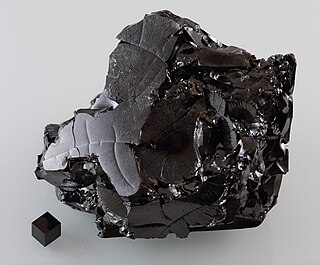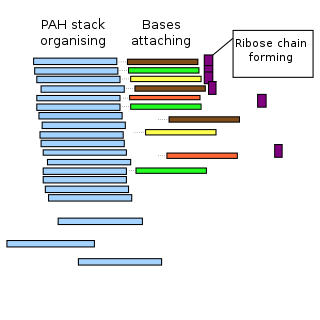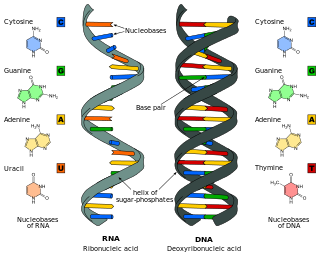 W
WThe term autopoiesis refers to a system capable of reproducing and maintaining itself by creating its own parts and eventually further components. The original definition can be found in the 1972 publication Autopoiesis and Cognition: The Realization of the Living by Chilean biologists Humberto Maturana and Francisco Varela to define the self-maintaining chemistry of living cells. Since then the concept has been also applied to the fields of cognition, systems theory, architecture and sociology.
 W
WThe Avalon explosion, named from the Precambrian fauna of the Avalon Peninsula, is a proposed evolutionary radiation in the history of the Animalia, about 575 million years ago in the Ediacaran Period, some 33 million years earlier than the Cambrian explosion.
 W
WBradykinin is a peptide that promotes inflammation. It causes arterioles to dilate (enlarge) via the release of prostacyclin, nitric oxide, and endothelium-derived hyperpolarizing factor and makes veins constrict, via prostaglandin F2, thereby leading to leakage into capillary beds, due to the increased pressure in the capillaries. Bradykinin is a physiologically and pharmacologically active peptide of the kinin group of proteins, consisting of nine amino acids.
 W
WCarbon chauvinism is a neologism meant to disparage the assumption that the chemical processes of hypothetical extraterrestrial life must be constructed primarily from carbon because as far as we know, carbon's chemical and thermodynamic properties render it far superior to all other elements.
 W
WThe cooperative eye hypothesis is a proposed explanation for the appearance of the human eye. It suggests that the eye's distinctive visible characteristics evolved to make it easier for humans to follow another's gaze while communicating or while working together on tasks.
 W
WThe Eocyte hypothesis is a biological classification that indicates eukaryotes emerged within the prokaryotic Crenarchaeota, a phylum within the archaea. This hypothesis was originally proposed by James A. Lake and colleagues in 1984 based on the discovery that the shapes of ribosomes in the Crenarchaeota and eukaryotes are more similar to each other than to either bacteria or the second major phylum of archaea, the Euryarchaeota.
 W
WExtraterrestrial life is hypothetical life that may occur outside Earth and which did not originate on Earth. Such life might range from simple prokaryotes to intelligent beings and even sapient beings, possibly bringing forth civilizations that might be far more advanced than humanity. The Drake equation speculates about the existence of sapient life elsewhere in the universe. The science of extraterrestrial life in all its forms is known as astrobiology.
 W
WThe Gaia hypothesis, also known as the Gaia theory, Gaia paradigm, or the Gaia principle, proposes that living organisms interact with their inorganic surroundings on Earth to form a synergistic and self-regulating, complex system that helps to maintain and perpetuate the conditions for life on the planet.
 W
WHemolithin is a proposed protein containing iron and lithium, of extraterrestrial origin, according to an unpublished preprint. The result has not been published in any peer-reviewed scientific journal. The protein was purportedly found inside two CV3 meteorites, Allende and Acfer-086, by a team of scientists led by Harvard University biochemist Julie McGeoch. The report of the discovery was met with some skepticism and suggestions that the researchers had extrapolated too far from incomplete data.
 W
WThe multiregional hypothesis, multiregional evolution (MRE), or polycentric hypothesis is a scientific model that provides an alternative explanation to the more widely accepted "Out of Africa" model of monogenesis for the pattern of human evolution.
 W
WNeocatastrophism is the hypothesis that life-exterminating events such as gamma-ray bursts have acted as a galactic regulation mechanism in the Milky Way upon the emergence of complex life in its habitable zone. It is proposed as an explanation of Fermi's paradox since it provides a mechanism which would have delayed the otherwise expected advent of intelligent beings in the local galaxy nearby to Earth. This is an avenue to explain why none so far have been detected by humans.
 W
WThe PAH world hypothesis is a speculative hypothesis that proposes that polycyclic aromatic hydrocarbons (PAHs), known to be abundant in the universe, including in comets, and assumed to be abundant in the primordial soup of the early Earth, played a major role in the origin of life by mediating the synthesis of RNA molecules, leading into the RNA world. However, as yet, the hypothesis is untested.
 W
WPanspermia is the hypothesis that life exists throughout the Universe, distributed by space dust, meteoroids, asteroids, comets, and planetoids, as well as by spacecraft carrying unintended contamination by microorganisms. Panspermia is a fringe theory with little support amongst mainstream scientists. Critics argue that it does not answer the question of the origin of life but merely places it on another celestial body. It was also criticized because it was thought it could not be tested experimentally.
 W
WThe RNA world is a hypothetical stage in the evolutionary history of life on Earth, in which self-replicating RNA molecules proliferated before the evolution of DNA and proteins. The term also refers to the hypothesis that posits the existence of this stage.
 W
WSpontaneous generation is a body of thought on the ordinary formation of living organisms without descent from similar organisms. The theory of spontaneous generation held that living creatures could arise from nonliving matter and that such processes were commonplace and regular. It was hypothesized that certain forms, such as fleas, could arise from inanimate matter such as dust, or that maggots could arise from dead flesh. A variant idea was that of equivocal generation, in which species such as tapeworms arose from unrelated living organisms, now understood to be their hosts. The idea of univocal generation, by contrast, refers to effectively exclusive reproduction from genetically related parent(s), generally of the same species.
 W
WSymbiogenesis, endosymbiotic theory, or serial endosymbiotic theory, is the leading evolutionary theory of the origin of eukaryotic cells from prokaryotic organisms. The theory holds that mitochondria, plastids such as chloroplasts, and possibly other organelles of eukaryotic cells are descended from formerly free-living prokaryotes taken one inside the other in endosymbiosis. The idea that chloroplasts were originally independent organisms that merged into a symbiotic relationship with other one-celled organisms dates back to the 19th century, when it was espoused by researchers such as Andreas Schimper.